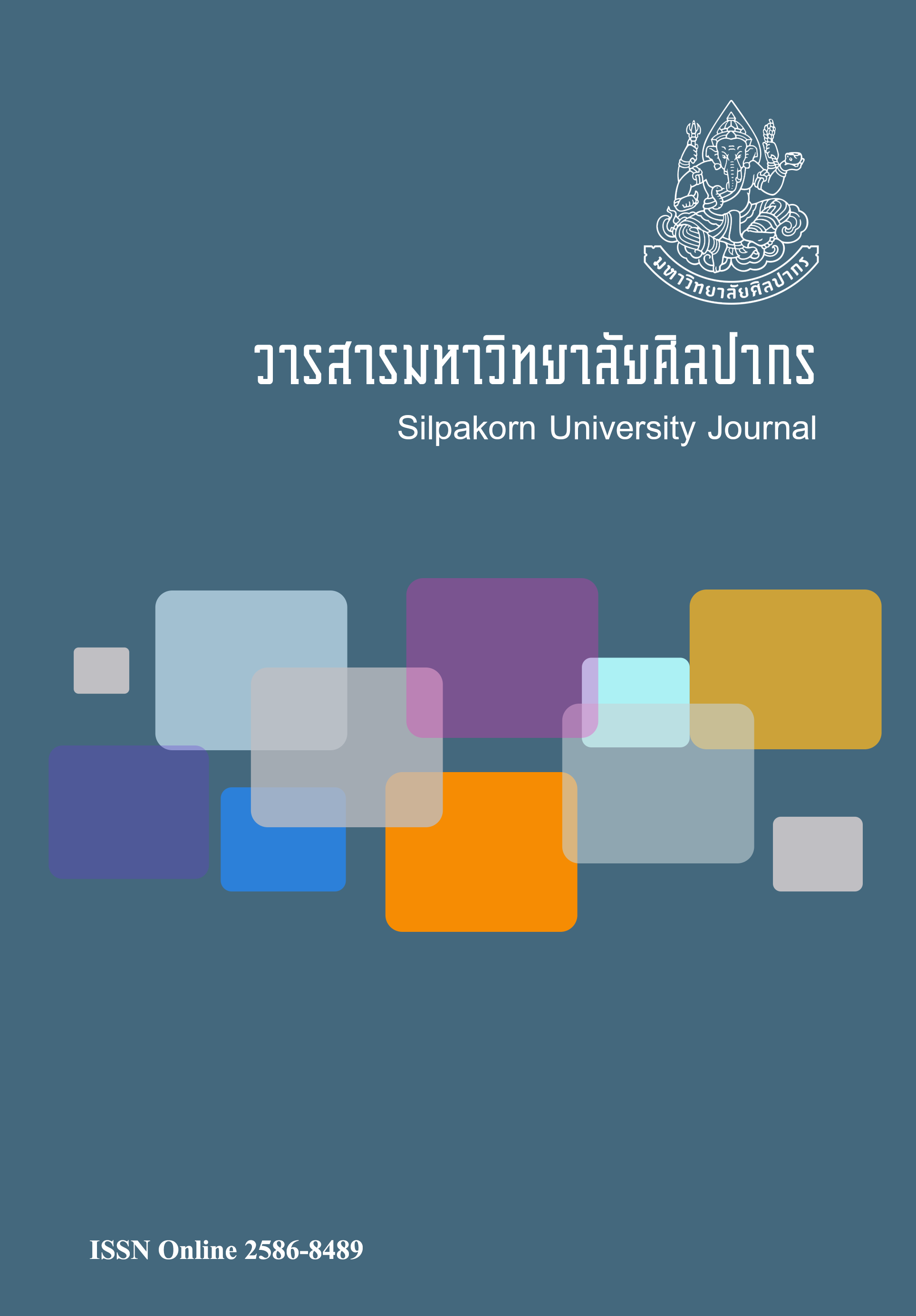การสอนคำศัพท์ที่ปรากฏร่วมกันเพื่อส่งเสริมความสามารถในการอ่านและการเขียนภาษาอังกฤษของนักศึกษาระดับปริญญาตรี (Teaching collocation to promote English reading and writing abilities of undergraduate students)
Main Article Content
Abstract
การวิจัยครั้งนี้มีวัตถุประสงค์เพื่อ 1) เปรียบเทียบความสามารถในการอ่านภาษาอังกฤษของผู้เรียนก่อนและหลังการสอนคำศัพท์ที่ปรากฏร่วมกัน 2) ศึกษาความสามารถในการเขียนภาษาอังกฤษหลังการสอนคำศัพท์ที่ปรากฏร่วมกัน กลุ่มเป้าหมายคือ นักศึกษาระดับปริญญาตรี สาขาวิชาภาษาอังกฤษเพื่อการสื่อสารสากล มหาวิทยาลัยเทคโนโลยีราชมงคลล้านนา ลำปาง จำนวน 20 คน เครื่องมือที่ใช้ในการวิจัยประกอบด้วย 1) แผนการจัดการเรียนรู้การสอนคำศัพท์ที่ปรากฏร่วมกัน จำนวน 5 แผน แผนละ 4 คาบ คาบละ 50 นาที รวม 20 คาบ 2) แบบทดสอบวัดความสามารถในการอ่านภาษาอังกฤษ 3) แบบประเมินความสามารถในการเขียนภาษาอังกฤษ สถิติที่ใช้ในการวิจัย ได้แก่ ค่าเฉลี่ย ส่วนเบี่ยงเบนมาตรฐาน และค่าร้อยละ ผลการวิจัย พบว่า 1) การทำแบบทดสอบวัดความสามารถในการอ่านภาษาอังกฤษของผู้เรียนสูงขึ้นหลังการสอนคำศัพท์ที่ปรากฏร่วมกัน 2)การประเมินผลความสามารถในการเขียนภาษาอังกฤษของผู้เรียนหลังการสอนคำศัพท์ที่ปรากฏร่วมกัน ผ่านเกณฑ์ที่กำหนดไว้
The objectives of this research were to: 1) compare students’ English reading ability before and after learning through collocation teaching, and 2) to investigate students’ English writing ability after learning through collocation teaching. The target group was 20 undergraduates at Rajamangala University of Technology Lanna Lampang majoring in English for International Communication. The research instruments were: 1) collocation teaching lesson plans which contained 5 lessons, each lesson was 4 periods and each period was 50 minutes; 2) an English reading comprehension test; and 3) an English writing assessment form. The statistics used in this research comprised mean, standard deviation, and percentage. The results were as follow. 1) Students’ English reading ability was higher after learning through collocation teaching. 2) Student’s English writing ability was higher than the criteria after learning through collocation teaching.
Downloads
Article Details
References
Chall, J. S. (1987). Two vocabularies for reading: Recognition and meaning. In The nature of vocabulary acquisition, edited by M.G.McKeown, & M.E. Curtis, pp. 7-15. Hillsdale, New York: Erbaum.
Chanturia A. S. (2015). Collocation in beginner learner writing: A longitudinal study. ScienceDirect Journal, 53(1): 148-160. [Online]. Retrieved September 18, 2014 from http://www.sciencedirect.com/science/article/ pii/S0346251X15001062
Chaowang, N. (2008). An Investigation of English Reading Problem of Thai students in Matthayom 6 Educational Service Area office 1, 2, 3, and 7 (การสำรวจปัญหาการอ่านภาษาอังกฤษของนักเรียนไทยชั้น มัธยมศึกษาปี ที่ 6 เขตพื้นที่การศึกษานครราชสีมา เขต 1, 2, 3 และ 7). Master’s dissertation, Srinakharinwirot University, Bangkok, Thailand.
Clouston, M. (1994). Challenging Student Approaches to ESL Vocabulary Development. TESL Canada Journal, 12(1): 69-80.
Hudson T. (2007). Teaching Second Language Reading. Oxford: Oxford University Press.
Kala, P. (2012). Collocation instruction to enhance english vocabulary knoeledge and writing ability among Mathayom Suksa 5 students (การสอนคำศัพท์ที่ปรากฏร่วมกันเพื่อเพิ่มพูนความรู้คำศัพท์และความสามารถในการเขียนภาษาอังกฤษของนักเรียนชั้นมัธยมศึกษาปีที่ 5). Master’s dissertation, Chiang Mai University, Chiang Mai, Thailand.
Krashen, S. D. (1988). Second Language Acquisition and Second Language Learning. California: Prentice-Hall International.
Krashen, S. D. (1987). Principles and Practice in Second Language Acquisition. Prentice-Hall International.
Intaraprasit, N. (2013). Investigation of Collocations Occurence in English Novels (การศึกษาการปรากฏของคําปรากฏร่วมในหนังสือนวนิยาย ภาษาอังกฤษ). Proceedings of the 6th academic symposium Rajamangala University of Technology Tawan-ok. pp.1110-1116.
Lanui, K. (1995). Teaching English for Communication on Mathayomsuksa. Master’s Degree. Songkranakarin University, Pattani Campus.
Lewis, M. (1997). Implementing the Lexical Approach: Putting Theory into Practice. England: Language Teaching Publications.
Lewis, M. (Ed.). (2000). Teaching Collocation: Further Developments in the Lexical Approach. Oxford: Oxford University Press.
Luengtairat, T. (2014). Use of Lexical Approach to Promote English Vocabulary Knowledge, Reading Ability, and Motivation Among Vocational Certificate Students (การใช้แนวการสอนภาษาที่เน้นคำศัพท์เพื่อส่งเสริมความรู้คำศัพท์ภาษาอังกฤษ ความสามารถทางการอ่านและแรงจูงใจของนักศึกษาระดับประกาศนียบัตรวิชาชีพ), Educational Research, Lanna Polytechnic College, Chiang Mai, Thailand.
McCarthy, M. & O’Dell, F. (2007). English phrasal verbs in use: advanced. Cambridge, Cambridge University Press.
McCarthy, M. & O’Dell, F. (2005). English Collocation in Use. Cambridge, Cambridge University Press.
Mewald, C. (2015). Lexical Range and Communicative Competence of Learners in Bilingual Schools in Lower Austria. Global Education Review, 2(2): 98-113.
Nagy, W., & P. Herman. (1987). Breadth and depth of vocabulary knowledge: Implications for acquisition and instruction.In The nature of vocabulary acquisition, edited by M. McKeown & M. Curtis, pp.19-32. Hillsdale, New York: Erbaum.
Nagy, W., and Herman, P. (1987). Learning word meanings from context during normal reading. American Educational Research Journal, 24(2): 237-270.
Osman, N.B. (2009). Routinizing lexical phrases on spoken discourse. International Education Studies, 2(2): 188-191.
Pannarangsri A. (2012). Use of reciprocal teaching to promote English reading ability, writing ability and vocabulary retention among Mathayom Suksa 4 students (การใช้การสอนอ่านแบบแลกเปลี่ยนบทบาทเพื่อส่ง เสริมความสามารถในการอ่าน ความสามารถในการเขียนภาษาอังกฤษ และความคงทนในการจำคำศัพท์ของนักเรียนชั้นมัธยมศึกษาปีที่ 4). Master’s dissertation, Chiang Mai University, Chiang Mai, Thailand.
Pikulski, J. J., and Templeton, S. (2004). Teaching and Developing Vocabulary: Key to Long-Term Reading Success. Houghton Mifflin Company: U.S.A. [Online]. Retrieved May 3, 2016 from www.eduplace.com
Redman, S. & Shaw, E. (1999). Vocabulary in Use. UK: Cambridge University Press.
Rungworaphong, P. (2014). Problems in Writing English of the New-Entry University Students: A Case Study of Prince of Songkla University, Trang Campus (ปัญหาการเขียนภาษาอังกฤษของนักศึกษาใหม่ : กรณีศึกษา มหาวิทยาลัยสงขลานครินทร์ วิทยาเขตตรัง), Rajabhat Maha Sarakham University Journal (Humanities and Social Sciences), 8(3): 119-126. [Online]. Retrieved from http://www.tcithaijo.org/index.php/rmuj/artice/ view/27971/24022
Schmitt, N. (2000). Vocabulary in Language Teaching. University of Nottingham: Cambridge University Press. [Online]. Retrieved from http://assets. cambridge.org/052166/0483/sample/0521660483wsn01
Suthapannakul, R. and Chattiwat, W. (2016). The Development of Technical English Reading Instructional Model Focusing on Task and Project-Based Learning to Enhance Reading Comprehension and Creative Thinking of Undergraduate Students (การพัฒนารูปแบบการสอนภาษาอังกฤษเทคนิค โดยวิธีการสอนที่เน้นภาระงานและโครงงานเพื่อพัฒนาการอ่านภาษาอังกฤษ เพื่อความเข้าใจและความคิดสร้างสรรค์ของนักศึกษาปริญญาตรี). Silpakorn Educational Research Journal, 8(1): 167-182.
Suvarnamani, S. (2017). Factors Related to Learning Achievement in Studying Business English of Thai Students: A Case Study of Fundamental Business English Course in University Level (ปัจจัยที่สัมพันธ์กับผลสัมฤทธิ์ ทางการเรียนภาษาอังกฤษธุรกิจของนักศึกษาไทย: กรณีศึกษารายวิชาภาษา อังกฤษธุรกิจพื้นฐานในระดับมหาวิทยาลัย). Silpakorn University Journal, 37(2): 289-308.
The office of Academic Promotion and Registration. (2008). Education Measurement and Evaluation of Regulation of Rajamangala University of Technology Lanna Lampang in Bachelor Dgree. In Teaching Approaches Regulation of Students Handbook, year 2014. Rajamangala University of Technology Lanna Lampang Students Handbook, pp. 193-212. n.p.
Thitichaikawin, D. and Yamkasikorn, M. (2017). Development of Curiosity Instructional Model for Lower Secondary School Student, the Non-Formal and Informal Education Center, Chonburi Province (การพัฒนารูปแบบ การสอน เพื่อพัฒนาความใฝ่รู้ของนักเรียนระดับมัธยมศึกษาตอนต้น ศูนย์การ ศึกษานอกระบบและการศึกษาตามอัธยาศัยจังหวัดชลบุรี). Silpakorn Educational Research Journal, 9(1): 243-256.
Thongngam, K. and Lowriendee, W. (2014). The Development of English Reading Instructional Model Based on Interactive Reading Approach to Enhance Critical Reading Abilities for Eleventh Grade Students (การพัฒนารูปแบบการสอนอ่านภาษาอังกฤษ ตามแนวการอ่านแบบปฏิสัมพันธ์ เพื่อส่งเสริมความ สามารถในการอ่านอย่างมีวิจารณญาณ สำหรับนักเรียนชั้นมัธยมศึกษาปีที่ 5). Silpakorn Educational Research Journal, 6(2): 67-79.
Vygotsky, L.S. (1986). Thought and Language. Cambridge, MA: MIT Press.


